Alternative CLM deployment topologies 5.0
Authors: DavidChadwick, GrantCovellBuild basis: The Rational solution for Collaborative Lifecycle Management (CLM) 5.0, 5.0.1, 5.0.2
Standard topologies overview
This page describes the Alternative CLM Deployment Topologies for version 5.x. Refer to Standard deployment topologies overview for high-level description of the standard topologies, how they are categorized and their key characteristics. These alternative deployment topologies for the Rational solution for Collaborative Lifecycle Management (CLM) are a subset of the standard CLM deployment topologies. For the rest of the standard topologies, see Recommended CLM deployment topologies for release 5.Alternate evaluation topology
(CLM-V1) Evaluation - Single server / Tomcat / Derby
This is a simple, single server topology whose primary use is supporting evaluations, demonstrations, proofs of concept and training. Given the use of Derby and Tomcat, it can be stood up very quickly, especially with the upcoming express install feature.| Metadata Variable | Value |
| Operating System | Windows |
| Database Management System | Derby |
| Application Server | Tomcat |
| License Management System | Trial |
| User Management System | Tomcat |
| Other technologies | None |
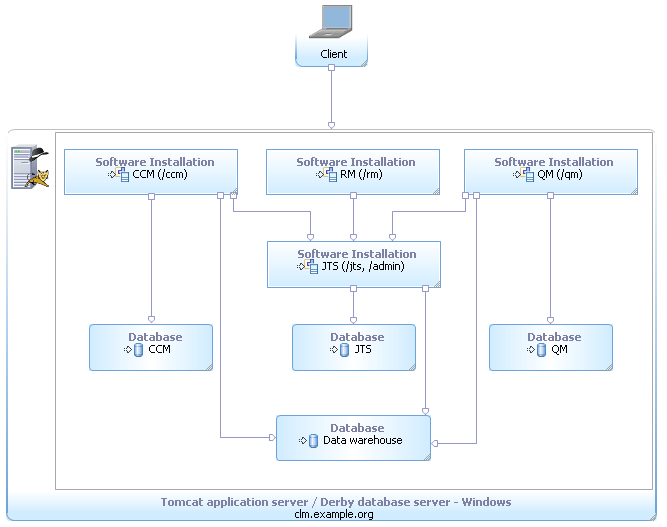
(CLM-V1) Evaluation - Single server / Tomcat / Derby
Alternate departmental topologies
(CLM-D1) Departmental - Single application server, Windows / DB2
This departmental topology uses Windows for the server operating systems. The CLM applications and JTS are deployed to a single WAS instance. Virtual host names are used to ensure public URI stability. DB2 is used for the databases and is hosted on a separate server. Rational Reporting for Development Intelligence (RRDI) is included in this department configuration but is hosted on a separate server and WAS instance for performance reasons. Finally, licenses are served by a floating license server and Active Directory provides the Lightweight Directory Access Protocol (LDAP) based user management.| Metadata Variable | Value |
| Operating System | Windows |
| Database Management System | DB2 |
| Application Server | WAS |
| License Management System | Floating |
| User Management System | Active Directory |
| Other technologies | Virtual host names |
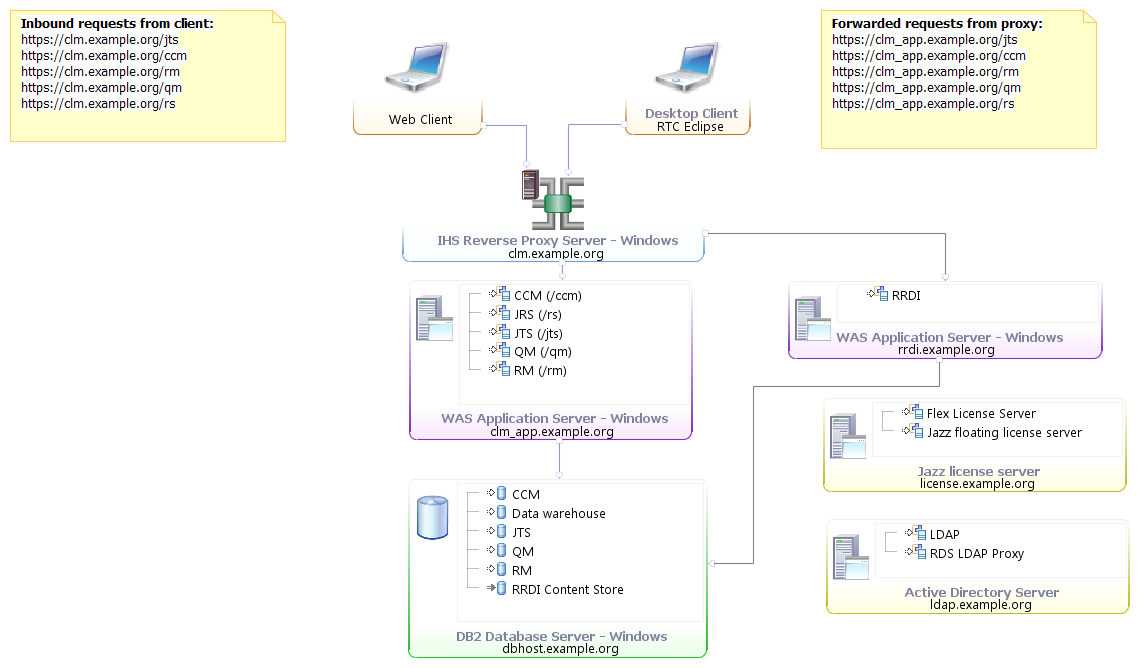
(CLM-D1) Departmental - Single application server, Windows / DB2
Alternate enterprise topologies
(CLM-E3) Enterprise - Linux / Oracle
This enterprise topology uses Linux for the server operating systems. The CLM applications and JTS are each deployed on separate WAS nodes. RRDI is hosted on a separate server pending completion of reliability and performance tests. A load balancer fronts multiple reverse proxy servers (used to ensure public URI stability) and balances the inbound requests between them. Oracle is used for the databases and is hosted on a separate server. Finally, licenses are served by a token license server and Tivoli Directory Server provides the LDAP based user management.| Metadata Variable | Value |
| Operating System | Linux |
| Database Management System | Oracle |
| Application Server | WAS |
| License Management System | Token |
| User Management System | Tivoli Directory Server |
| Other technologies | Load Balancer, Reverse Proxy |
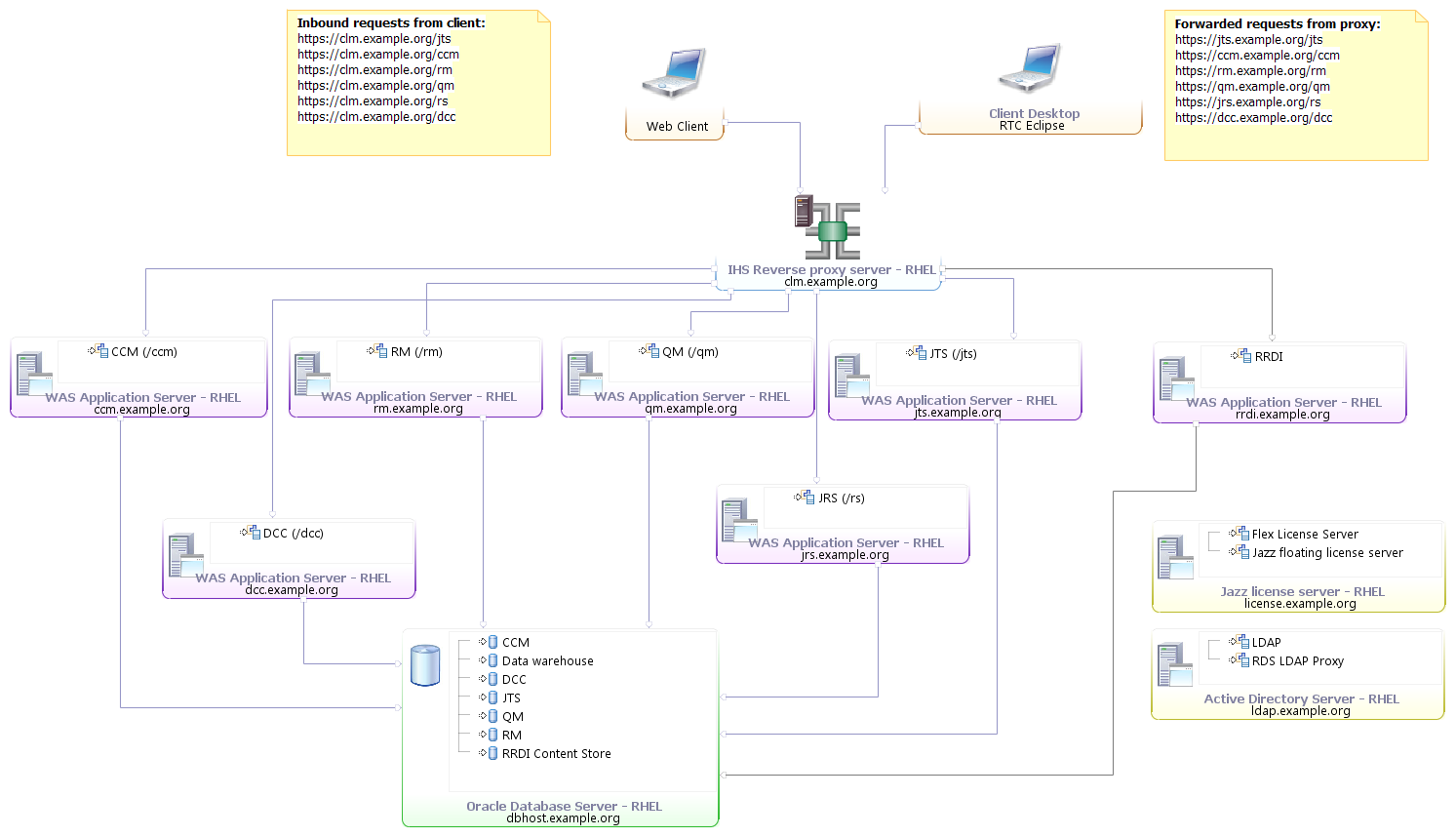
(CLM-E3) Enterprise - Linux / Oracle
(CLM-E4) Enterprise - AIX / all IBM
This enterprise topology uses AIX for the server operating systems. The CLM applications, JTS and RRDI are each deployed to separate WAS nodes each in a separate LPAR. A load balancer fronts multiple reverse proxy servers (used to ensure public URI stability) and balances the inbound requests between them. DB2 is used for the databases and is hosted on a separate server. The server-side converter.war, needed to view graphical artifacts in RRC, is deployed on a Linux server. Finally, licenses are served by a token license server and the AIX LDAP server provides the user management.| Metadata Variable | Value |
| Operating System | AIX |
| Database Management System | DB2 |
| Application Server | WAS |
| License Management System | Token |
| User Management System | AIX LDAP server |
| Other technologies | Load Balancer, Reverse Proxy |

(CLM-E4) Enterprise - AIX / all IBM NOTE: Diagram being revised.
(CLM-E5) Enterprise - zOS / Linux on System z / DB2
This enterprise topology uses Linux on System z for the operating system on the CLM server. The CLM applications, RRDI and JTS run in separate profiles on a single WAS instance. A reverse proxy is used to ensure public URI stability. DB2 is used for the databases and is hosted on a separate z/OS LPAR. Finally, licenses are served by a floating license server and Tivoli Directory Server provides the LDAP based user management. Each of these run on a Linux server.| Metadata Variable | Value |
| Operating System | Linux on system z |
| Database Management System | DB2 |
| Application Server | WAS |
| License Management System | Token |
| User Management System | Tivoli Directory server |
| Other technologies | Reverse Proxy |
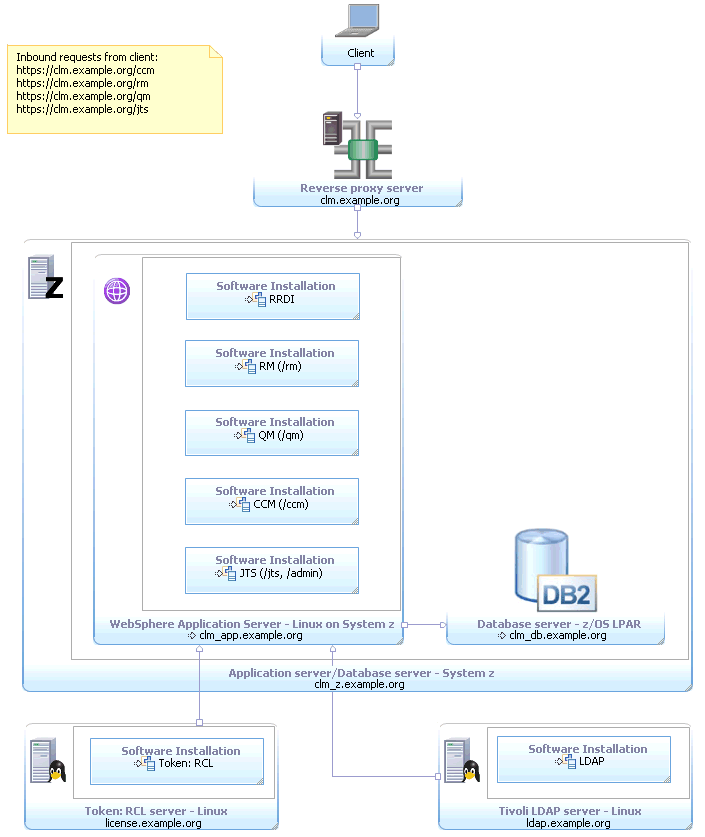
(CLM-E5) Enterprise - zOS / Linux on System z / DB2
(CLM-E6) Enterprise - zOS / DB2
This enterprise topology uses z/OS for the operating system on the CLM. The CLM applications and JTS run in separate profiles on a single WAS instance. RRDI does not run on z/OS so is deployed on WAS hosted on a Linux server. A reverse proxy is used to ensure public URI stability. DB2 is used for the databases and is hosted on a separate LPAR. Finally, licenses are served by a floating license server running on Linux and Resource Access Control Facility (RACF) provides the user management.| Metadata Variable | Value |
| Operating System | z/OS |
| Database Management System | DB2 |
| Application Server | WAS |
| License Management System | Token |
| User Management System | RACF |
| Other technologies | Reverse Proxy |
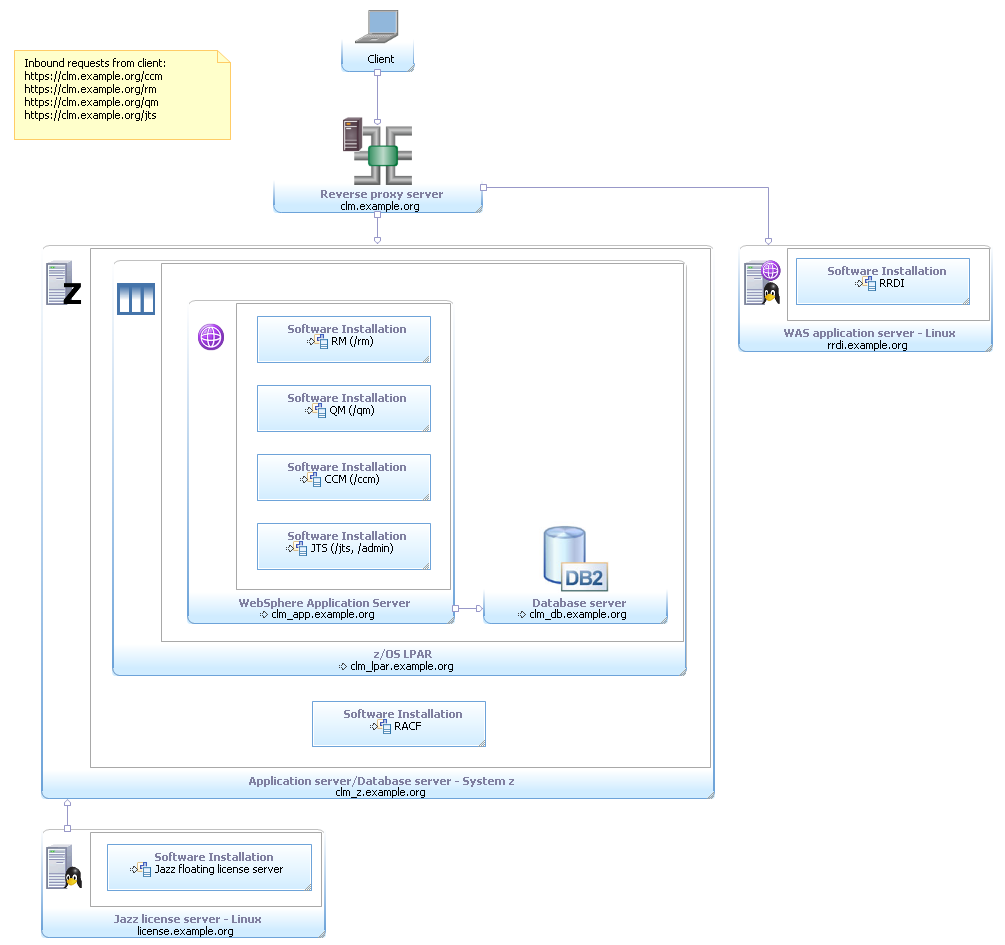
(CLM-E6) Enterprise - zOS / DB2
Applying the topologies
Every customer's environment is different with unique, necessary and often immutable requirements and constraints. We recognize that these standard topologies may not provide enough detail to make them immediately implementable in some customer environments, but we wanted to describe several topologies with enough variability to give an indication of what is possible and where our recommendations start. While we recommend customers start with a standard topology that is most applicable to them, we recognize they will need to make changes and customizations to support their own unique requirements and constraints. IBM will support your own implementations, but may ask you to describe which topology is most applicable to your deployment and ask you to document what is unique in your environment to expedite any potential support situation. To aid you in documenting your chosen deployment topology, we have made the following Rational Software Architect (RSA) model files available:- CLM standard topologies
- CLM standard topologies 5.0.2
- SSE standard topologies 4.0.3 and 4.0.4
- SSE standard topologies 4.0.5
- SSE standard topologies 4.0.6
- SSE standard topologies 5.0.0
- SSE standard topologies 5.0.1
- SSE standard topologies 5.0.2
Datasheets and sizing guidelines
Find CLM-specific performance datasheets, sizing guidelines and performance-related case studies on the Performance datasheets and sizing guidelines page.Next steps
This topic is meant to briefly introduce these standard topologies and describe how they might be applied. Work is already underway to build upon and apply them. Subsequent updates to this topic and supporting topics will provide additional insight into their usage. Future updates to this topic or supporting topics may cover:- Deeper look at select topologies
- Provide suggested tuning parameters
- Consider high availability database topologies
- Begin to expand this topology model into other domains
- Discussion of strategic integrations with other Rational and non-Rational products.
Related topics: Recommended CLM deployment topologies, Deployment planning and design
External links:
- None
Additional contributors: None
Contributions are governed by our Terms of Use. Please read the following disclaimer.
Dashboards and work items are no longer publicly available, so some links may be invalid. We now provide similar information through other means. Learn more here.